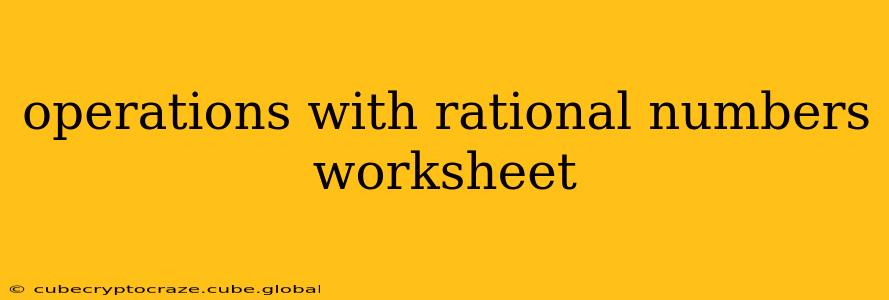This guide provides a detailed walkthrough of operations with rational numbers, addressing common questions and challenges students face. We'll cover addition, subtraction, multiplication, and division, ensuring you gain a solid understanding of these fundamental mathematical concepts. Whether you're a student needing extra help or a teacher looking for supplementary materials, this guide will equip you with the knowledge and practice needed to master rational number operations.
What are Rational Numbers?
Before diving into operations, let's define our subject. Rational numbers are numbers that can be expressed as the quotient or fraction p/q of two integers, a numerator p and a non-zero denominator q. This includes integers, fractions, terminating decimals, and repeating decimals. Examples include: 1/2, -3, 0.75, and 2.333...
Adding and Subtracting Rational Numbers
Adding and subtracting rational numbers requires a common denominator. If the denominators are already the same, simply add or subtract the numerators and keep the denominator unchanged.
Example: 1/4 + 3/4 = (1+3)/4 = 4/4 = 1
If the denominators are different, find the least common multiple (LCM) of the denominators and rewrite the fractions with this common denominator.
Example: 1/3 + 1/2 = (2/6) + (3/6) = 5/6
Subtraction follows the same principle: find a common denominator and subtract the numerators.
Example: 2/5 - 1/3 = (6/15) - (5/15) = 1/15
How do I add mixed numbers?
To add mixed numbers (a whole number and a fraction), you can convert them into improper fractions first. An improper fraction is where the numerator is larger than or equal to the denominator. Then, follow the addition steps outlined above.
Example: 2 1/2 + 1 1/4 = (5/2) + (5/4) = (10/4) + (5/4) = 15/4 = 3 3/4
How do I subtract mixed numbers with different denominators?
Similar to addition, convert mixed numbers to improper fractions, find a common denominator, and then subtract the numerators.
Example: 3 1/3 - 1 1/2 = (10/3) - (3/2) = (20/6) - (9/6) = 11/6 = 1 5/6
Multiplying Rational Numbers
Multiplying rational numbers is straightforward: multiply the numerators together and multiply the denominators together. Simplify the resulting fraction if possible.
Example: (2/3) * (4/5) = (24)/(35) = 8/15
When multiplying mixed numbers, convert them to improper fractions first.
Dividing Rational Numbers
Dividing rational numbers involves inverting (reciprocating) the second fraction (the divisor) and then multiplying.
Example: (1/2) ÷ (3/4) = (1/2) * (4/3) = 4/6 = 2/3
Remember to convert mixed numbers to improper fractions before dividing.
What is the reciprocal of a rational number?
The reciprocal of a rational number is obtained by swapping its numerator and denominator. The reciprocal of a/b is b/a (assuming 'a' is not zero).
How do I divide mixed numbers?
Convert the mixed numbers into improper fractions and then follow the division steps above.
Working with Negative Rational Numbers
The rules for operations with negative rational numbers are similar to those for integers:
- Addition: Adding a negative rational number is the same as subtracting its positive counterpart.
- Subtraction: Subtracting a negative rational number is the same as adding its positive counterpart.
- Multiplication and Division: The rules for signs are the same as for integers:
- Positive * Positive = Positive
- Positive * Negative = Negative
- Negative * Negative = Positive
- The same rules apply to division.
This comprehensive guide provides a solid foundation for understanding and performing operations with rational numbers. Remember practice makes perfect! Regular practice with various examples will solidify your understanding and improve your skills.
